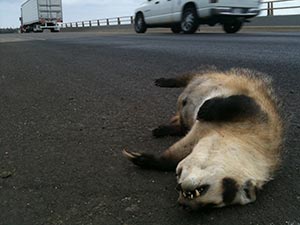Road-associated Mortality
Roads and vehicles can have profound impacts on the abundance and distribution of organisms. Road kill is the most obvious direct effect of roads upon wildlife. Wildlife-vehicle collisions precede the advent of automobiles and continue to be an issue of concern to this day (Forman et al. 2003). Forman and Alexander (1998) imply that this problem is growing in scope, with an estimated one million vertebrates (or animals with backbones) per day killed on roads in the United States. This puts vehicle-animal collisions above hunting as a mortality source for terrestrial vertebrates.

Pictured above: Road Kill. An American badger (Taxidea taxus) observed October 11, 2009 on Hueneme Road in unincorporated Ventura County, California.
Citizen Science
“Citizen Science” is a relatively new term for an old idea: people who are not full-time scientists doing science. Anyone who is interested in observing the world around them with a quantitative eye is a potential scientist. The increasing power and affordability of various technologies (such as this smart phone in your hand) and access to high quality training and information in the form of guide books, web-based tutorials, and discussion groups is making it easier and easier for anyone to collect high quality data useful for testing hypotheses and improving our understanding of our world. This is all happening at a time when the need for such information is growing exponentially. Humanity’s footprint has grown to the extent that we are now threatening the very fabric of our living world. Documenting this impact and finding effective and equitable solutions is a too big a job for full-time scientists. Never before has Citizen Science been more helpful or more needed. And it can all start for you by downloading this app.
